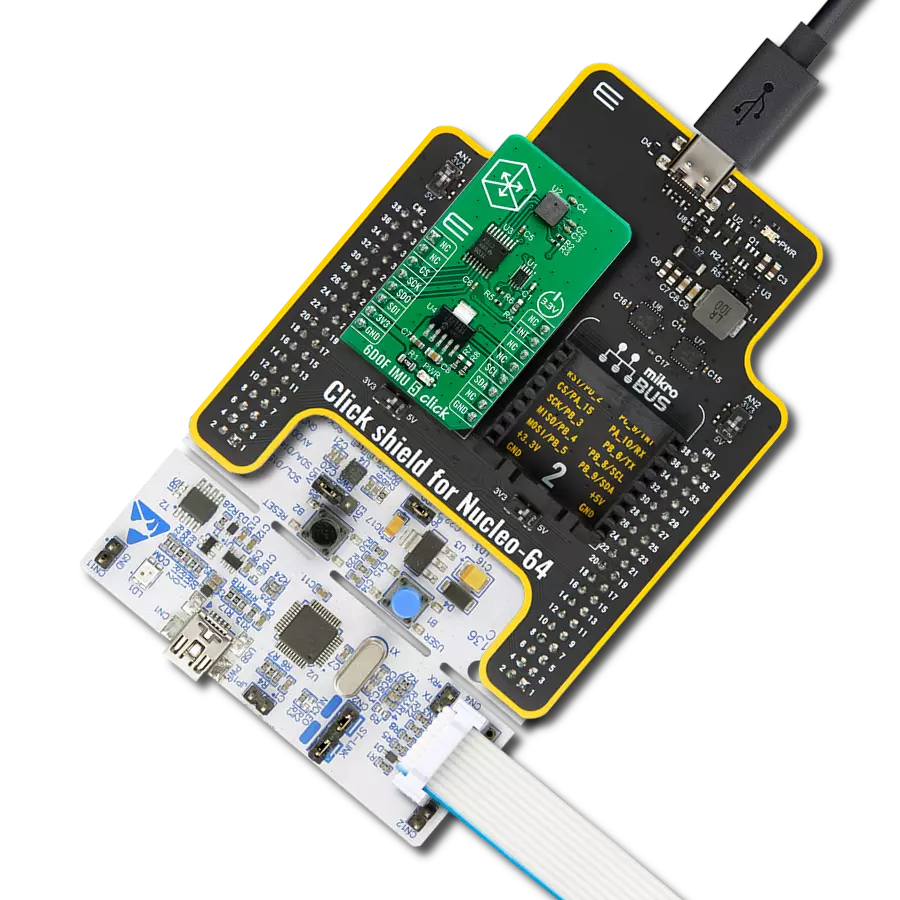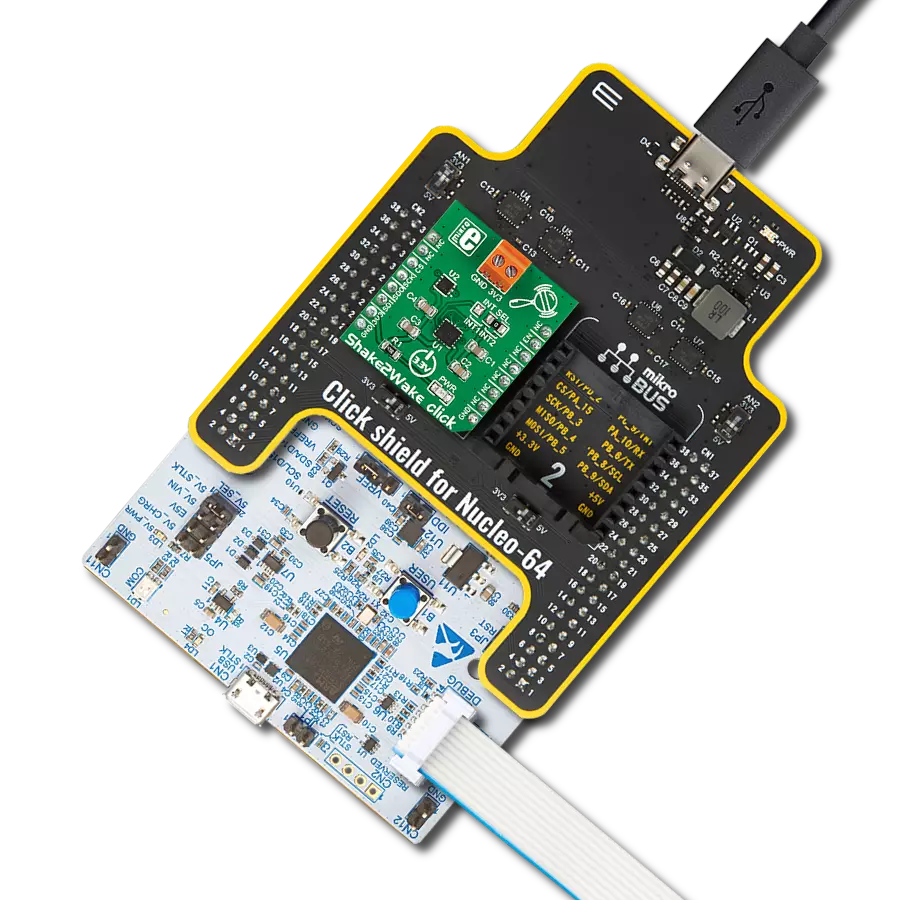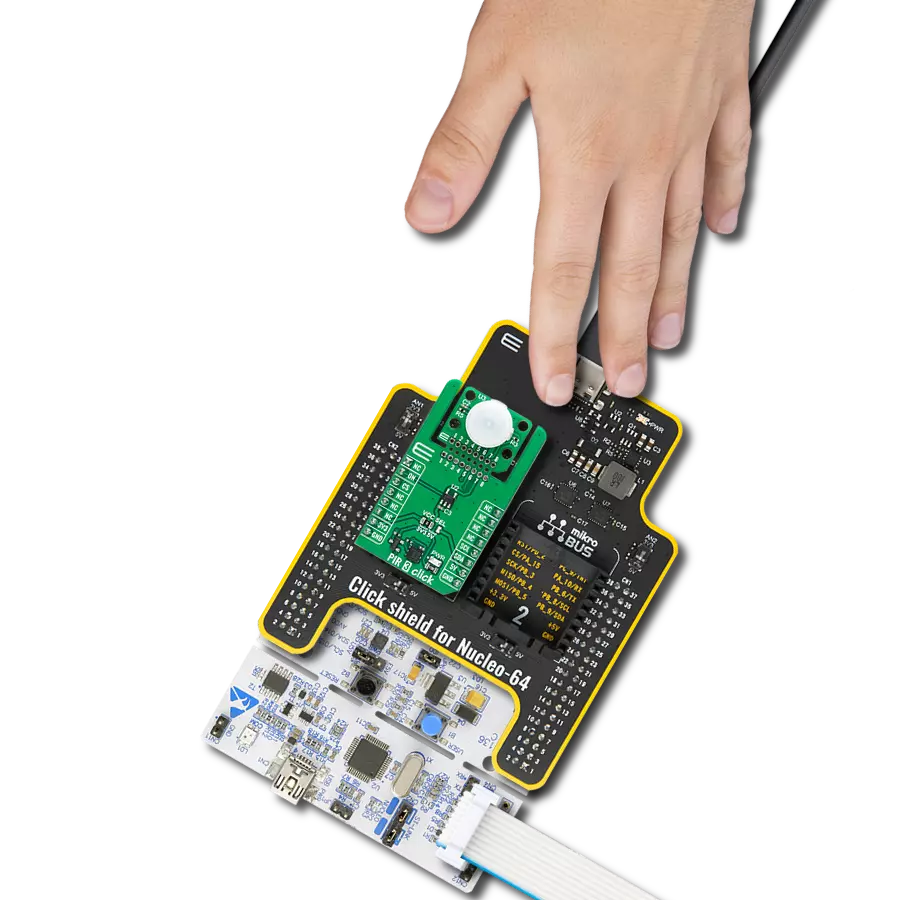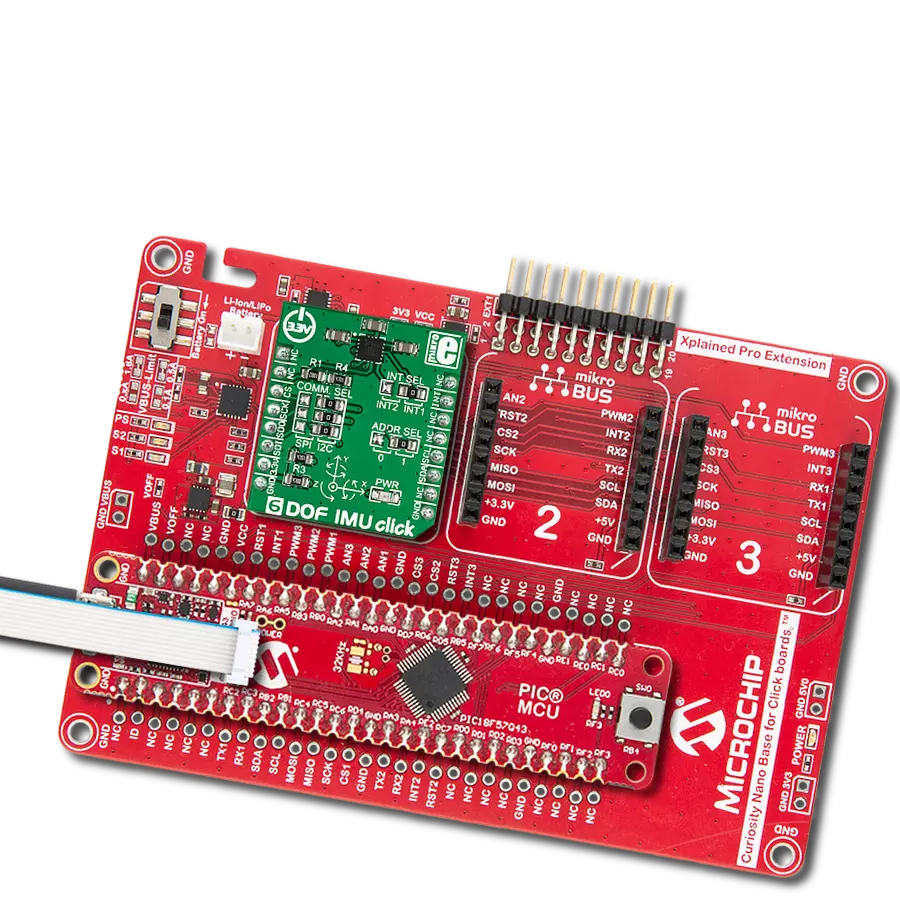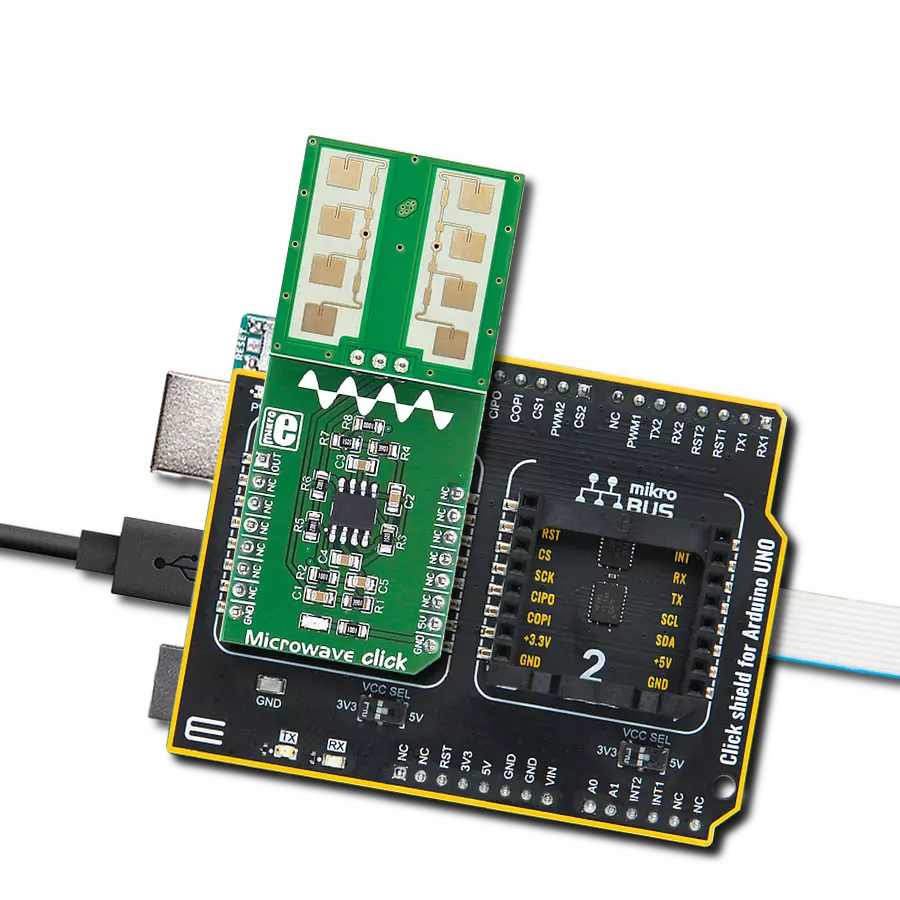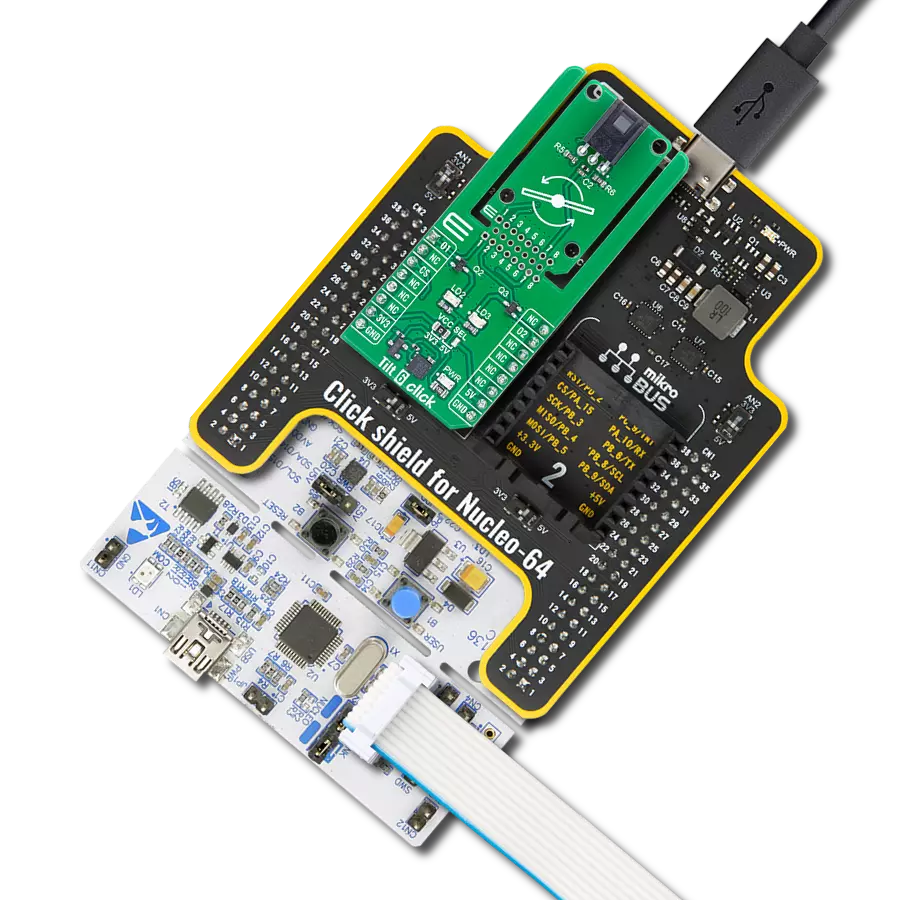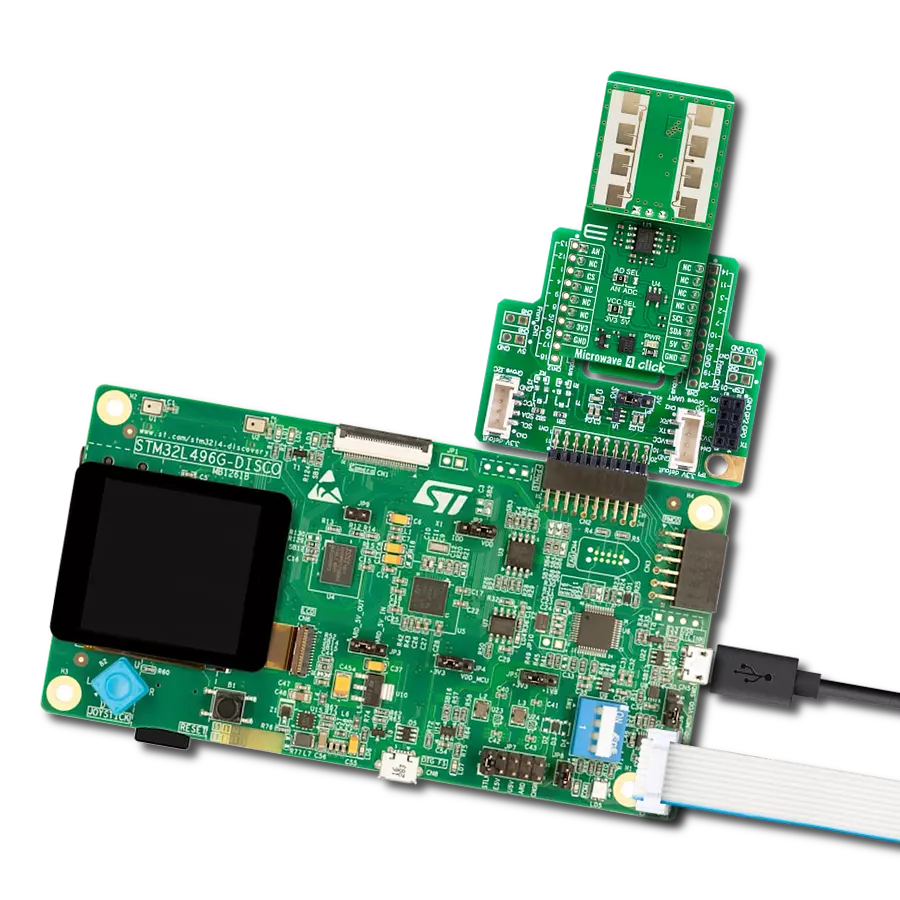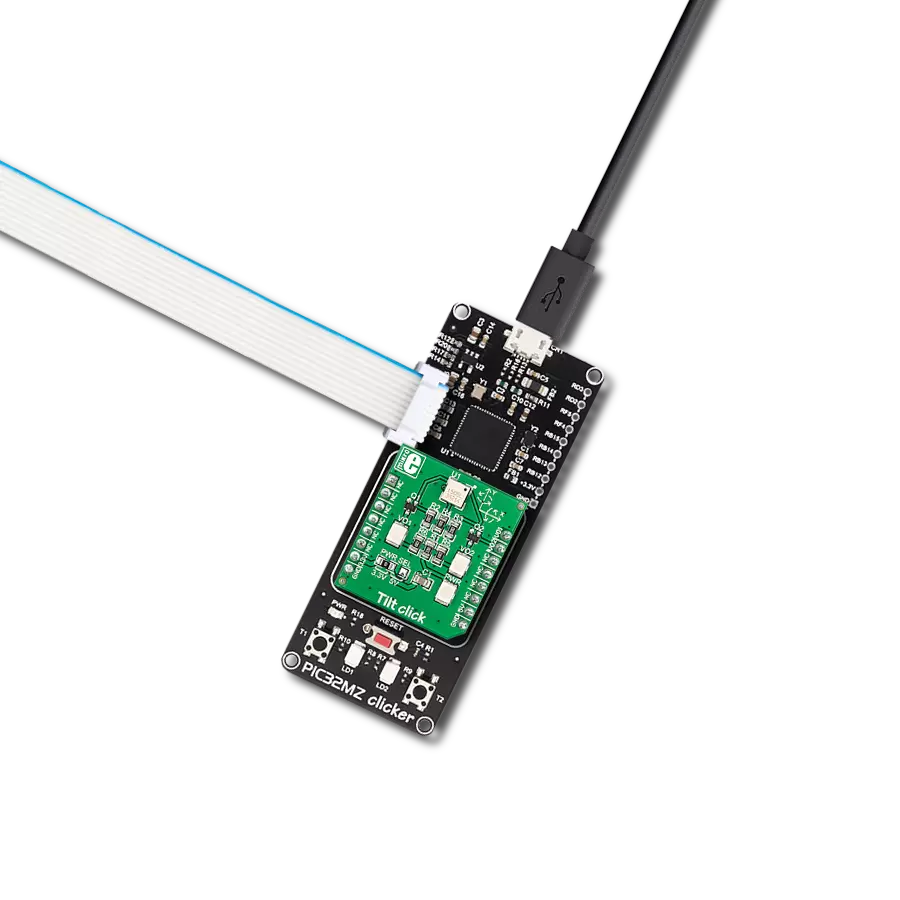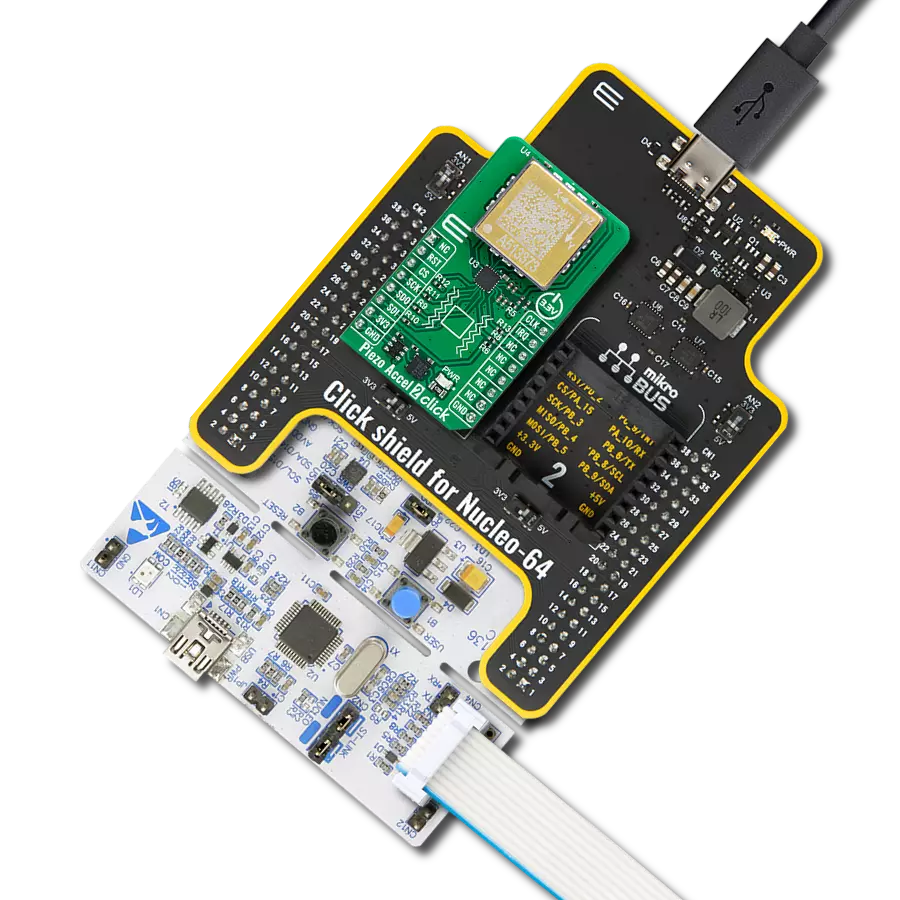Our mission is to infuse your projects with the enchantment of 6-axis motion sensing, unlocking entirely new possibilities for them to interact seamlessly with the physical world
A
A
Hardware Overview
How does it work?
6DOF IMU 5 Click is based on the ICM-20789, a 6-axis inertial sensor (3-axis gyroscope and a 3-axis accelerometer), and ultra-low noise MEMS capacitive barometric pressure sensor from TDK InvenSense. ICM-20789 features a 4 KB FIFO that can lower the traffic on the serial bus interface. The digital output barometric pressure sensor is based on an ultra-low noise innovative MEMS capacitive technology that can measure pressure differences with an accuracy of ±1 Pa, an accuracy enabling altitude measurement differentials as small as 8.5 cm without the penalty of increased power consumption or reduced sensor throughput. The capacitive pressure sensor has a ±1 hPa absolute accuracy over its full range of 300 hPa -1100 hPa. The pressure sensor offers industry leading temperature stability of the pressure sensor with a temperature coefficient offset of ±0.5 Pa/°C, embedded temperature sensor and 400kHz I2C
bus for communication. The gyroscope has a programmable full-scale range of ±250 dps, ±500 dps, ±1000 dps, and ±2000 dps. The accelerometer has a user-programmable full-scale range of ±2g, ±4g, ±8g, and ±16g. Factory-calibrated initial sensitivity of both sensors reduces production-line calibration requirements. Other features include on-chip 16-bit ADCs, programmable digital filters, another embedded temperature sensor, and programmable interrupts. The device features I2C serial interface to access its registers at 400 kHz as well as at 8 MHz SPI. The onboard chip ICM-20789 requires stable voltage for power supply of input/output pins (VDDIO) at 1.8V which also supplies the pressure sensor. 6DOF IMU 5 click does all of the power supply regulations as well as the logic level translations needed for proper operation. The MCP1826, a 1000 mA Low Dropout (LDO) linear regulator provides high-current and
low-output voltage of 1.8V to all of the essential parts of the board, while TXB0106 and PCA9306 do the SPI and I2C signal level translations, respectively, between the MCU and the ICM-20789. Interacting with the 6-axis is possible through SPI communication protocol while the I2C bus allows access to pressure sensors 16-bit address space registers. This device is intended for implementation in Drones and Flying Toys, Motion-based gaming controllers, Virtual Reality Headsets & Controllers, Indoor/Outdoor Navigation (dead-reckoning, floor/elevation/step detection). This Click Board™ uses both I2C and SPI communication interfaces. It is designed to be operated only with 3.3V logic levels. A proper logic voltage level conversion should be performed before the Click board™ is used with MCUs with logic levels of 5V.
Features overview
Development board
Nucleo-64 with STM32F091RC MCU offers a cost-effective and adaptable platform for developers to explore new ideas and prototype their designs. This board harnesses the versatility of the STM32 microcontroller, enabling users to select the optimal balance of performance and power consumption for their projects. It accommodates the STM32 microcontroller in the LQFP64 package and includes essential components such as a user LED, which doubles as an ARDUINO® signal, alongside user and reset push-buttons, and a 32.768kHz crystal oscillator for precise timing operations. Designed with expansion and flexibility in mind, the Nucleo-64 board features an ARDUINO® Uno V3 expansion connector and ST morpho extension pin
headers, granting complete access to the STM32's I/Os for comprehensive project integration. Power supply options are adaptable, supporting ST-LINK USB VBUS or external power sources, ensuring adaptability in various development environments. The board also has an on-board ST-LINK debugger/programmer with USB re-enumeration capability, simplifying the programming and debugging process. Moreover, the board is designed to simplify advanced development with its external SMPS for efficient Vcore logic supply, support for USB Device full speed or USB SNK/UFP full speed, and built-in cryptographic features, enhancing both the power efficiency and security of projects. Additional connectivity is
provided through dedicated connectors for external SMPS experimentation, a USB connector for the ST-LINK, and a MIPI® debug connector, expanding the possibilities for hardware interfacing and experimentation. Developers will find extensive support through comprehensive free software libraries and examples, courtesy of the STM32Cube MCU Package. This, combined with compatibility with a wide array of Integrated Development Environments (IDEs), including IAR Embedded Workbench®, MDK-ARM, and STM32CubeIDE, ensures a smooth and efficient development experience, allowing users to fully leverage the capabilities of the Nucleo-64 board in their projects.
Microcontroller Overview
MCU Card / MCU
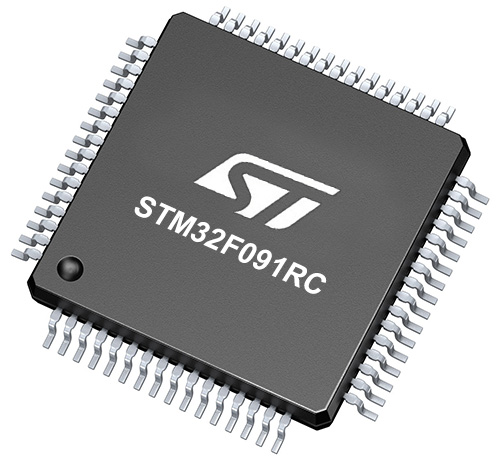
Architecture
ARM Cortex-M0
MCU Memory (KB)
256
Silicon Vendor
STMicroelectronics
Pin count
64
RAM (Bytes)
32768
You complete me!
Accessories
Click Shield for Nucleo-64 comes equipped with two proprietary mikroBUS™ sockets, allowing all the Click board™ devices to be interfaced with the STM32 Nucleo-64 board with no effort. This way, Mikroe allows its users to add any functionality from our ever-growing range of Click boards™, such as WiFi, GSM, GPS, Bluetooth, ZigBee, environmental sensors, LEDs, speech recognition, motor control, movement sensors, and many more. More than 1537 Click boards™, which can be stacked and integrated, are at your disposal. The STM32 Nucleo-64 boards are based on the microcontrollers in 64-pin packages, a 32-bit MCU with an ARM Cortex M4 processor operating at 84MHz, 512Kb Flash, and 96KB SRAM, divided into two regions where the top section represents the ST-Link/V2 debugger and programmer while the bottom section of the board is an actual development board. These boards are controlled and powered conveniently through a USB connection to program and efficiently debug the Nucleo-64 board out of the box, with an additional USB cable connected to the USB mini port on the board. Most of the STM32 microcontroller pins are brought to the IO pins on the left and right edge of the board, which are then connected to two existing mikroBUS™ sockets. This Click Shield also has several switches that perform functions such as selecting the logic levels of analog signals on mikroBUS™ sockets and selecting logic voltage levels of the mikroBUS™ sockets themselves. Besides, the user is offered the possibility of using any Click board™ with the help of existing bidirectional level-shifting voltage translators, regardless of whether the Click board™ operates at a 3.3V or 5V logic voltage level. Once you connect the STM32 Nucleo-64 board with our Click Shield for Nucleo-64, you can access hundreds of Click boards™, working with 3.3V or 5V logic voltage levels.
Used MCU Pins
mikroBUS™ mapper
Take a closer look
Click board™ Schematic

Step by step
Project assembly
Track your results in real time
Application Output
1. Application Output - In Debug mode, the 'Application Output' window enables real-time data monitoring, offering direct insight into execution results. Ensure proper data display by configuring the environment correctly using the provided tutorial.

2. UART Terminal - Use the UART Terminal to monitor data transmission via a USB to UART converter, allowing direct communication between the Click board™ and your development system. Configure the baud rate and other serial settings according to your project's requirements to ensure proper functionality. For step-by-step setup instructions, refer to the provided tutorial.

3. Plot Output - The Plot feature offers a powerful way to visualize real-time sensor data, enabling trend analysis, debugging, and comparison of multiple data points. To set it up correctly, follow the provided tutorial, which includes a step-by-step example of using the Plot feature to display Click board™ readings. To use the Plot feature in your code, use the function: plot(*insert_graph_name*, variable_name);. This is a general format, and it is up to the user to replace 'insert_graph_name' with the actual graph name and 'variable_name' with the parameter to be displayed.

Software Support
Library Description
This library contains API for 6DOF IMU 5 Click driver.
Key functions:
c6dofimu5_power- This function turns the device on or offc6dofimu5_read_gyroscope- This function is used to read gyroscope datac6dofimu5_read_accelerometer- This function is used to read accelerometer data
Open Source
Code example
The complete application code and a ready-to-use project are available through the NECTO Studio Package Manager for direct installation in the NECTO Studio. The application code can also be found on the MIKROE GitHub account.
/*!
* \file
* \brief C6DofImu5 Click example
*
* # Description
* This example demonstrates the use of 6DOF IMU 5 Click board.
*
* The demo application is composed of two sections :
*
* ## Application Init
* Initializes the driver, checks the communication and sets the device
* default configuration.
*
* ## Application Task
* Measures acceleration, gyroscope, temperature and pressure data and
* displays the results on USB UART each second.
*
* \author MikroE Team
*
*/
// ------------------------------------------------------------------- INCLUDES
#include "board.h"
#include "log.h"
#include "c6dofimu5.h"
// ------------------------------------------------------------------ VARIABLES
static c6dofimu5_t c6dofimu5;
static log_t logger;
// ------------------------------------------------------ APPLICATION FUNCTIONS
void application_init ( void )
{
log_cfg_t log_cfg;
c6dofimu5_cfg_t cfg;
uint8_t id_val;
/**
* Logger initialization.
* Default baud rate: 115200
* Default log level: LOG_LEVEL_DEBUG
* @note If USB_UART_RX and USB_UART_TX
* are defined as HAL_PIN_NC, you will
* need to define them manually for log to work.
* See @b LOG_MAP_USB_UART macro definition for detailed explanation.
*/
LOG_MAP_USB_UART( log_cfg );
log_init( &logger, &log_cfg );
log_info( &logger, "---- Application Init ----" );
// Click initialization.
c6dofimu5_cfg_setup( &cfg );
C6DOFIMU5_MAP_MIKROBUS( cfg, MIKROBUS_1 );
c6dofimu5_init( &c6dofimu5, &cfg );
c6dofimu5_read_bytes ( &c6dofimu5, C6DOFIMU5_WHO_AM_I, &id_val, 1 );
if ( id_val == C6DOFIMU5_WHO_AM_I_VAL )
{
log_printf( &logger, "-------------------------\r\n " );
log_printf( &logger, " 6DOF IMU 5 Click \r\n " );
log_printf( &logger, "-------------------------\r\n " );
c6dofimu5_power ( &c6dofimu5, C6DOFIMU5_POWER_ON );
}
else
{
log_printf( &logger, "-------------------------\r\n " );
log_printf( &logger, " FATAL ERROR!!! \r\n " );
log_printf( &logger, "-------------------------\r\n " );
for ( ; ; );
}
c6dofimu5_default_cfg( &c6dofimu5 );
c6dofimu5_baro_settings( &c6dofimu5 );
log_printf( &logger, " ---Initialised--- \r\n " );
log_printf( &logger, "-------------------------\r\n " );
Delay_ms ( 100 );
}
void application_task ( void )
{
float x_gyro;
float y_gyro;
float z_gyro;
float x_accel;
float y_accel;
float z_accel;
uint32_t raw_pres;
uint16_t raw_temp;
c6dofimu5_process_data_t process_data;
c6dofimu5_acceleration_rate( &c6dofimu5, &x_accel, &y_accel, &z_accel );
c6dofimu5_angular_rate( &c6dofimu5, &x_gyro, &y_gyro, &z_gyro );
log_printf( &logger, " Accel X: %.2f \t Gyro X: %.2f\r\n", x_accel, x_gyro );
log_printf( &logger, " Accel Y: %.2f \t Gyro Y: %.2f\r\n", y_accel, y_gyro );
log_printf( &logger, " Accel Z: %.2f \t Gyro Z: %.2f\r\n", z_accel, z_gyro );
log_printf( &logger, "-------------------------\r\n " );
c6dofimu5_read_raw_data( &c6dofimu5, &raw_pres, &raw_temp );
process_data.p_raw = raw_pres;
process_data.t_raw = raw_temp;
c6dofimu5_process_data( &c6dofimu5, &process_data );
log_printf( &logger, "Pressure: %.2f mBar\r\n " , process_data.pressure * 0.01 );
log_printf( &logger, "Temperature: %.2f Celsius\r\n " , process_data.temperature );
log_printf( &logger, "-------------------------\r\n" );
Delay_ms ( 1000 );
}
int main ( void )
{
/* Do not remove this line or clock might not be set correctly. */
#ifdef PREINIT_SUPPORTED
preinit();
#endif
application_init( );
for ( ; ; )
{
application_task( );
}
return 0;
}
// ------------------------------------------------------------------------ END
Additional Support
Resources
Category:Motion
